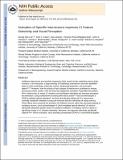Activation of specific interneurons improves V1 feature selectivity and visual perception
Author(s)
Lee, Seung-Hee; Kwan, Alex C.; Zhang, Siyu; Phoumthipphavong, Victoria; Flannery, John G.; Masmanidis, Sotiris C.; Taniguchi, Hiroki; Huang, Z. Josh; Zhang, Feng; Deisseroth, Karl; Dan, Yang; Boyden, Edward; ... Show more Show less
DownloadBoyden_Activation specific.pdf (1.246Mb)
PUBLISHER_POLICY
Publisher Policy
Article is made available in accordance with the publisher's policy and may be subject to US copyright law. Please refer to the publisher's site for terms of use.
Terms of use
Metadata
Show full item recordAbstract
Inhibitory interneurons are essential components of the neural circuits underlying various brain functions. In the neocortex, a large diversity of GABA (γ-aminobutyric acid) interneurons has been identified on the basis of their morphology, molecular markers, biophysical properties and innervation pattern1, 2, 3. However, how the activity of each subtype of interneurons contributes to sensory processing remains unclear. Here we show that optogenetic activation of parvalbumin-positive (PV+) interneurons in the mouse primary visual cortex (V1) sharpens neuronal feature selectivity and improves perceptual discrimination. Using multichannel recording with silicon probes4, 5 and channelrhodopsin-2 (ChR2)-mediated optical activation6, we found that increased spiking of PV+ interneurons markedly sharpened orientation tuning and enhanced direction selectivity of nearby neurons. These effects were caused by the activation of inhibitory neurons rather than a decreased spiking of excitatory neurons, as archaerhodopsin-3 (Arch)-mediated optical silencing7 of calcium/calmodulin-dependent protein kinase IIα (CAMKIIα)-positive excitatory neurons caused no significant change in V1 stimulus selectivity. Moreover, the improved selectivity specifically required PV+ neuron activation, as activating somatostatin or vasointestinal peptide interneurons had no significant effect. Notably, PV+ neuron activation in awake mice caused a significant improvement in their orientation discrimination, mirroring the sharpened V1 orientation tuning. Together, these results provide the first demonstration that visual coding and perception can be improved by increased spiking of a specific subtype of cortical inhibitory interneurons.
Date issued
2012-08Department
Massachusetts Institute of Technology. Department of Biological Engineering; Massachusetts Institute of Technology. Department of Brain and Cognitive Sciences; Massachusetts Institute of Technology. Media Laboratory; Program in Media Arts and Sciences (Massachusetts Institute of Technology)Journal
Nature
Publisher
Nature Publishing Group
Citation
Lee, Seung-Hee, Alex C. Kwan, Siyu Zhang, et al. 2012 Activation of Specific Interneurons Improves V1 Feature Selectivity and Visual Perception. Nature 488(7411): 379–383.
Version: Author's final manuscript
ISSN
0028-0836
1476-4687